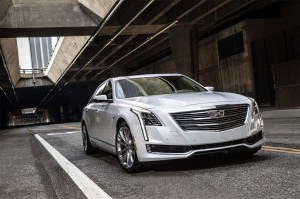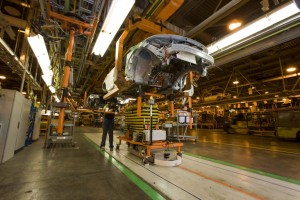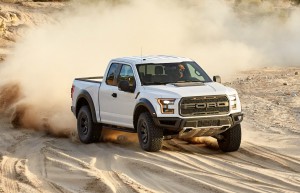The year is ending on a tenuous note for the U.S. auto industry. Even as sales records are set to fall for the third year in a row, bulging inventories are leading manufacturers to schedule production cuts, some short-term, others indefinite.
Thousands of workers are being impacted by the cuts at a time when the incoming Trump Administration has promised to boost U.S. manufacturing. The question for the near-term is whether further cuts are coming, something likely to depend on just how much the country’s car market slips in the months ahead.
The latest cuts come in Kansas City, where Ford Motor Co. will idle its pickup and van plant for a week early next month, and in Detroit, where General Motors says it will cut the second shift at a plant producing three sedans, as well as the plug-in hybrid Chevrolet Volt.
(The outlook for 2017 car sales isn’t upbeat. Click Here for the story.)
The Detroit-Hamtramck plant was already one of five factories GM said on Monday it would temporarily idle in a bit to bring production more in line with market demand. GM is also planning to eliminate shifts at its Lordstown, Ohio and Lansing, Michigan plants, starting next month. Those three moves alone will result in the indefinite loss of about 3,300 hourly jobs.
GM had already cut more than 1,000 workers when it dropped a shift at a factory in Orion Township, Michigan building its Chevrolet Sonic subcompact. That plant recently started building the new Chevy Bolt EV and could see some workers recalled if demand for the long-range battery-electric vehicle is strong enough, according to a plant official.
Then there’s Fiat Chrysler Automobiles, which recently shuttered its big Sterling Heights (Michigan) Assembly Plant, costing 1,700 jobs. The factory had been building the midsize Chrysler 200 sedan, but due to declining sales, FCA has decided to stop building any small passenger cars in the U.S. That led to the shutdown of another plant in Belvidere, Illinois earlier this year.
Both those plants will eventually come back on line as they are converted to produce more popular light truck models. While specific dates haven’t been released, FCA Chief Executive Sergio Marchionne has hinted that could happen about a year from now for Sterling Heights, which will produce the next-generation Ram 1500 pickup.
The two FCA plants reflect the various challenges the U.S. auto industry faces.
New vehicle sales are expected to end the year around 17.5 million, according to various analysts, a third consecutive industry record. But demand has been softening in recent months, and the big question for 2017 appears to be just how much sales will drop.

The production cuts reflect both a slowing US market and the shift from cars - like this Cadillac CT6 - to utes and other light trucks.
The general consensus is that the market will still come in at around 17 million vehicles, said Jeff Conrad, the head of the Honda brand in the U.S. “Just a few years ago,” he told TheDetroitBureau.com this week, “we were at 10 million, so that’s still a pretty good market.”
But a decline of 500,000 vehicles is nonetheless the equivalent of about two full assembly plants, and some manufacturers – and some products – will feel the impact more than others.
As the GM and FCA cutbacks reveal, passenger car plants are bearing the brunt of a massive industry transformation. As 2016 comes to a close, utility vehicles, pickups and other light trucks are generating over 60% of sales, up from less than 50% during the depths of the recession. Cheap gas has been a major contributor to that shift, but even as prices rise, analysts believe trucks will remain dominant – in part because newer models don’t suffer the mileage penalties of past products.
(Toyota changing up small car strategy. Click Here for more.)
Surging truck demand has caught most makers off guard. Bill Fay, the U.S. head of the Toyota brand, this month told TheDetroitBureau.com that the company has lost thousands of sales in 2016 because it had excess passenger car capacity and was short of utility vehicles like the big Highlander and smaller RAV4.
Volkswagen AG hopes to reverse a year of double-digit losses with the introduction of the new Atlas SUV. Meanwhile, Honda has actually set a number of records – for overall sales and for sales of its light truck models, in particular – by updating existing utility vehicles and adding the new Ridgeline pickup.
Detroit makers seem to be hardest hit by weakening passenger car sales. The largest of the domestic carmakers, it ended November with an 84-day dealer inventory level, up from 79 in October – and significantly higher than the 60 to 65-day supplies considered the industry norm, though that can vary depending upon the time of year.
GM has actually struggled to churn out enough trucks, such as the redesigned Chevrolet Equinox and the Buick Enclave, it has a 177-day backlog of Chevy Camaros, 168 days of the Buick LaCrosse, and 111 days worth of inventory for the Cadillac CT6.
Some analysts actually see a positive side to the industry production cuts, however. Leading up to the Great Recession, automakers kept piling more and more cash on the hood in the form of rebates, low-interest loans, subvented leases and other givebacks. In some cases, that amounted to more than $10,000 a vehicle.
And while it may have briefly helped spur sales, such deals ultimately helped dig the industry’s collective bottom line deeper and deeper in the red – both GM and the former Chrysler Corp. both going bankrupt, surviving only with federal bailouts.
Incentives have been on the rise, again, in recent months, but to nowhere near the levels seen as sales began falling in the past. Mark Fields, the CEO of Ford, has said the company will exercise a new “discipline,” and will “match production to demand,” even if that risks losing some market share.
It’s easy to be disciplined in a record market. The real test will come as auto sales reach their peak and start to slip in 2017.
(GM set to reveal complete makeovers of Chevy Traverse, GMC Terrain at Detroit Auto Show. Click Here for a preview.)



Forget building cars! Ford has a better idea, remodeling downtown Dearborn.
Wonder how Lincoln feels about the CT6 kind of bombing, especially not going with a RWD / AWD platform for the Continental.